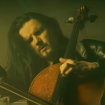Released in July 1983 as the fourth track on Metallica's debut, Kill 'Em All, and then in January 1984 as a single, "Jump in the Fire" is one of the thrash OGs' first original recordings, along with "Hit the Lights" and "No Remorse." It's also one of the handful of Metallica songs for which Dave Mustaine gets a writing credit, including "The Four Horsemen," "Metal Militia" and "Phantom Lord."
According to setlist.fm, "Jump in the Fire" is the 67th song most played live by Metallica, having been performed nearly 100 times. The band hasn't broke it out since 2016, however, and they left it out of their setlist for 20 years — from 1984 to 2004.
Even so, the cheerfully satanic, NWOHM-inflected number stands as a foundational song for Metallica. With that in mind, here are five eye-opening facts about "Jump in the Fire."
1. "Jump in the Fire" is the first song Dave Mustaine remembers writing
As Dave Mustaine told Rolling Stone in 2017, the first song he remembers writing was "Jump in the Fire," which he came up with at age 16, while in his early metal band Panic, before bringing it to Metallica in 1982.
"I was writing about myself being young and sitting in my room and feeling dejected — I had my head in my hands and didn't know what to do," he recalled. "I felt I had to get with my friends because I was at an age and a time when my mom was always gone and I was by myself and the only time I felt like I belonged was when I was with my friends."
Of course, despite writing it, Mustaine would never get the chance to record "Jump in the Fire" or any other song with Metallica, other than on a few demos.
2. Mustaine's original lyrics for "Jump in the Fire" were about sex
James Hetfield's lyrics for the Kill 'Em All classic were written from the perspective of the Devil, who tempts people with sin so they can ultimately "jump in the fire" of Hell. Mustaine's original lyrics, as heard on the No Life 'Til Leather demo, were very different, dealing with teen angst and sexual desire. Indeed, much like Megadeth's raunchy "Mechanix" — an early version of Metallica's "The Four Horsemen" that was literally about a gas-station tryst — Mustaine's "Jump in the Fire" lyrics include bawdy lines like "Moving my hips in a circular way/Just forward a bit/Pull your body into my waist/And feel how good it fits."
According to the Megadeth bandleader, both his lyrics for "Jump in the Fire" and "Mechanix" were reactions against his repressed religion upbringing by a mother who was a Jehovah's Witness. "Those were the writings of a young male who was not quite 21 yet and had been severely religiously abused from my mom's religion," he told Paste in 2016.
3. "Jump in the Fire" was Metallica's response to Iron Maiden's "Run to the Hills"
Kill 'Em All reflects Metallica's New Wave of British Heavy Metal influences more than any of their albums, and "Jump in the Fire," in particular, was inspired by NWOBHM titans Iron Maiden, specifically, their 1982 anthem "Run to the Hills," off that year's The Number of the Beast. In 2004, when Metallica played "Jump in the Fire" live for the first time in two decades, Lars Ulrich described the song as "our original attempt at 'Run to the Hills.'" He added the tidbit that "Jump in the Fire" was written "right at the time when 'Run to the Hills' was the biggest song on American radio."
4. The "live" recordings of "Phantom Lord" and "Seek & Destroy" featured on the B-side of the "Jump in the Fire" single aren't live at all
From the Rolling Stones (Got Live If You Want It!) to KISS (Alive!) to Type O Negative (The Origin of the Feces), many bands have released fake live albums featuring studio recordings with added crowd noises or live recordings heavily augmented with studio tracks or a mix of both. Metallica got into the "fake live" act with the January 1984 single for "Jump in the Fire," which included, on its B-side, "Phantom Lord (live)" and "Seek & Destroy (live)." Regardless of how the tracks were described in the parentheses in their titles, both were actually alternate studio recordings overdubbed with audience sounds — and pretty obviously so upon listening.
5. The single's artwork was originally part of a cover painting for a 1979 novel about satanic WWII demons
The horned, red-skinned beast emerging from flames on the cover of the "Jump in the Fire" single is one of the great pieces of Metallica iconography. In 2009, it was even turned into a collectible Metallica action figure. But it wasn't originally intended for the band at all.
In fact, the "Jump in the Fire" demon dates back to 1978, when artist Les Edward painted the image with oils on board for the cover of Graham Masterton's occult thriller The Devils of D-Day, released the following year. In the horror novel, a supernatural evil is unleashed after the hatch of a rusty old WWII tank is opened in a French village, and in the full original painting on the book's cover, the demon looms over the haunted armored combat vehicle of the story. Today the tank is long forgotten, of course, while the demon lives on thanks to Metallica, who, in 1984, used the top portion of Edward's painting for their single artwork. The rest, as they say, is history.













